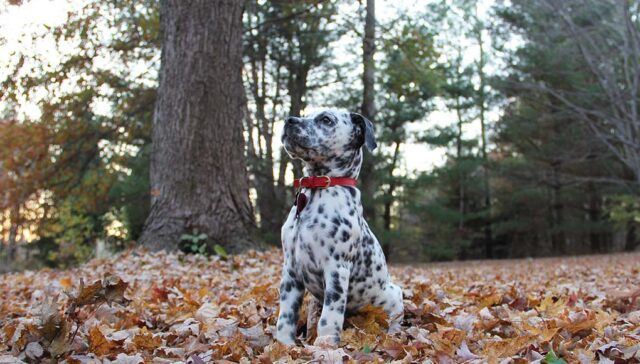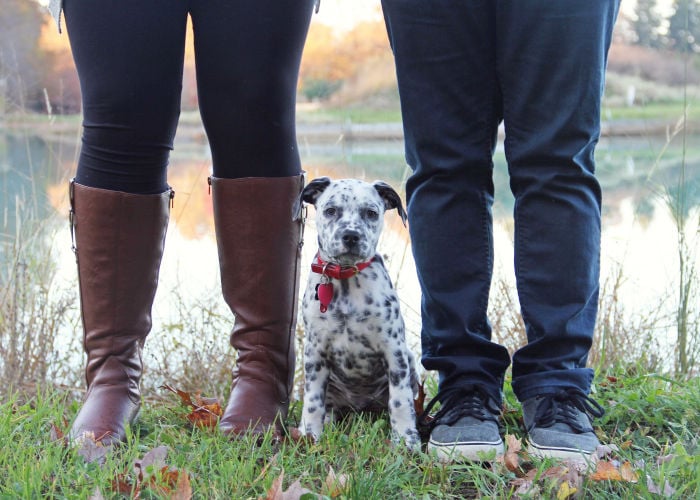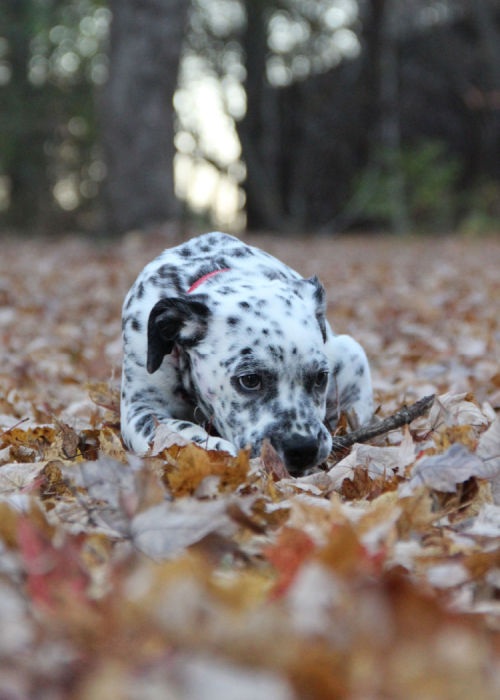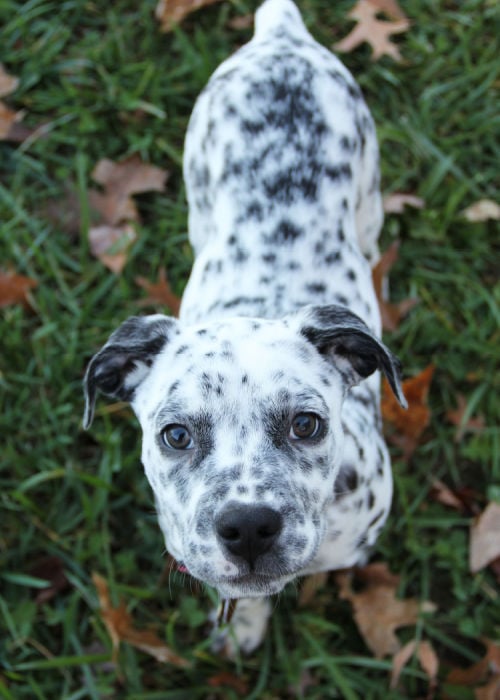
Table of Contents
Have you ever wondered what would a Bulldog and Dalmatian crossbreed look like?
Well, the answer is simple. They look adorable, and they are called Bullmatian.
Bullmatians are not just adorable pets, but they are also affectionate, energetic, and friendly.
The breed's popularity has increased over the years due to its unique appearance and nice personality.
This blog will tackle everything you need to learn about this mixed dog breed.
We'll discuss its physical traits, temperament, training, and exercise needs.
But before that, let's discuss the Bullmation's history.

Bullmatian History
Over the years, hybrid dogs have become more popular, creating or discovering many new breeds, including the Bullmatian.
The Bullmatian is a new hybrid mix between the Bulldog and Dalmatian first discovered in Afghanistan.
But their history began with the breed's parentage.
The Bulldog came from England in the 1500s, where they were used in bull baiting. However, once that practice was outlawed, Bulldogs transitioned as companion dogs.
On the other hand, Dalmatians are believed to come from the Romanies, who had spotted dogs.
These dogs were popular in England, where they were bred to be coaching dogs. They were responsible for clearing the path before horses ran alongside the coach.
Dalmatians changed career paths in the United States.
These dogs became firehouse dogs, where they ran with the horses to the fire, guarding and watching over the equipment in stations.
The Bullmatians' history has only a few years under their belt. But in this day in age, the Bullmatian is a designer dog breed.
Bullmatian Physical Characteristics
Bullmatians are usually defined as medium-sized dogs.
These beautiful dogs generally weigh around 41 to 65 pounds and stand 11 to 24 inches.
As you'd expect from a dog with a Dalmatian mix, the Bullmatian has a spotted coat which is the main attraction for most people.
These dogs are white with spots that can be black, brown, orange, fawn, red, or brindle.
Their coat is short and straight. If you're worrying about their grooming needs, it's relatively low maintenance, but we'll discuss the breed's grooming later on.
Bullmatian Temperament
Bullmatians are friendly and active dogs. They are very affectionate pets that love to follow their person all the time.
These dogs love to be the center of attention to their family, but they can be a bit more reserved towards strangers.
The breed's personality is somewhere between that of the Bulldog and Dalmatian.
And both of these breeds are known to be affectionate and loving, creating an excellent companion dog with the Bullmatian.
Living with a Bullmatian
Bullmatians are excellent family dogs. They are very affectionate pets that crave their owners' attention.
Generally, these dogs form a strong bond with their owner and young kids.
However, as pet owners, we must supervise all interactions between the children and the dog, no matter the breed, to prevent harm from both parties.
Teach children how to approach dogs properly. Tell them never to annoy them or try taking their food away while sleeping.
Socializing your Bullmatian at a young age will help in the long run, especially if you have several pets at home.
Fortunately, Bullmatians usually also do good around other pets.
The Bullmatian is also not recommended for first-time pet owners as these dogs tend to be stubborn at times.
RELATED: 10 Best Dog Breeds for First Time Owners

Training and Exercise
When training a Bullmatian, it's best to start early. Basic obedience training ensures that they grow into well-behaved and well-rounded adult dogs.
It's always best to use positive reinforcement training methods rather than fear. Remember that consistency is key when it comes to training.
Don't forget to socialize your pup at a young age. Exposure to different people, animals, and environments helps them become comfortable and confident in different situations.
Bullmatians, like Dalmatians, are intelligent dogs that require mental stimulation and physical exercise. Try puzzle toys, interactive games, and training sessions to challenge their brain and prevent boredom.
Boredom in dogs can lead to destructive behaviors. You wouldn't want to come home from work with your house in a wreck.
Regarding exercise, Bullmatians need at least 1 to 2 hours of activity per day.
There are plenty of ways to exercise a dog. You can go on daily walks. Aim for at least one or two walks per day.
Play sessions can also be a way to exercise your Bullmatian. Try playing tug-of-war, hide-and-seek, or some good old fashion fetch.
You can also enroll your dog to participate in dog sports or maybe swimming!
Bullmatian Health Care
The Bullmatian is generally a healthy dog with a life expectancy of 8 to 12 years!
Unfortunately, like other dog breeds, they are susceptible to certain health conditions you should look out for.
Finding a reputable breeder is best advised if you want to adopt a new pet. Trusted breeders can provide health clearances for the puppy and the puppy's parents.
Bullmatians are also prone to these health issues due to poor breeding practices.
Some breeds are prone to certain genetic health problems like hip dysplasia or cataracts.
Below, we've gathered a few health problems that Bullmatian dogs are prone to.
Entropion
Entropion is a defect seen as early as six months of age. This health problem causes the eyelid to roll inward, irritating or injuring the eyeball.
Monitor your dog if he is rubbing his eyes because this condition can affect both eyes. Fortunately, entropion can be corrected through surgery.
Patellar Luxation
Patellar luxation occurs when the patella moves its alignment out of the femur. Like the ones above, patellar luxation is a hereditary disorder in dogs.
This can range from high to low levels of luxation, and each requires different treatments.
Symptoms may include skipping and kicking off the leg. It’s best to contact the vet for treatments, therapies, or procedures to help your Bullmatian with this condition.
If your mixed breed has been diagnosed with patellar luxation, it should never be bred anymore.
It’s best not to bring these despairing conditions to their offspring.
Deafness
Deafness in dogs may depend if it is acquired through trauma, infection, or other underlying diseases, or it can be congenital.
Although it isn’t as prevalent with other breeds, deafness is congenital in the breed.
If the owner suspects their Bullmatian is deaf, they should have it checked and tested by their veterinarian.
There, they will be able to figure out if it’s bilateral or not and the grade of deafness with their dog.
Disabled dogs may require more assistance but do not mean they will do less for their owners.
It’s important to take care of these creatures more than ever. To anyone’s surprise, these can bring even more soul into your life.
Atopic Dermatitis
Atopic dermatitis happens when your pet’s immune system overreacts to an airborne allergen that gains access to the skin.
Some causes of allergies include fleas and skin contact with certain substances like pollens or molds.
Grooming
As we've discussed earlier, Bullmatians have short and straight coat that is relatively low-maintenance.
They do shed moderately, so regular brushing is enough. Brush your Bullmatian at least once or twice weekly to remove loose hair and dirt.
Check their ears regularly for signs of infection, redness, or wax buildup.
Regular nail trimming prevents overgrowth, discomfort, and potential injuries.
When trimming their nails, a good rule is never to let them touch the ground.
Dental care is crucial for dogs. Regular teeth cleaning is important to prevent dental issues.
Daily brushing is also recommended to avoid tartar buildup and remove bacteria lurking inside their mouths.

Frequently Asked Questions
What is a bullmatian dog?
A Bullmatian dog is the result of crossbreeding a Bulldog and a Dalmatian.
These adorable hybrid dogs are medium in size and live between 8 to 12 years.
What is the temperament of a bullmatian?
The Bullmatian's personality will be a mix of their parents' temperament.
Even though every dog is unique, these dogs are generally affectionate, smart, and love spending time with their owners.
Are Bulldogs good family dogs?
Bulldogs have a bad reputation due to their stubborn nature and strong stature. But they are actually great family pets.
They are affectionate dogs and loving to most children, and they crave attention from other family members.
Bullmatian Dog Breed Profile: Final Thoughts
Bullmatian is the adorable result when you mix a Dalmatian and a Bulldog. This beautiful hybrid's popularity has grown over the years.
These dogs are affectionate, active, and friendly. They have inherited a lot of the best qualities from their parents.
Bullmatians are one of the best companion dogs. They are loving and sociable dogs. They also do great around children and other pets.
If you want to adopt a Bullmatian puppy, remember that these active dogs need exercise and training.
They are also prone to health problems such as patellar luxation, entropion, and more. So, it's always best to adopt one from a reputable breeder.












